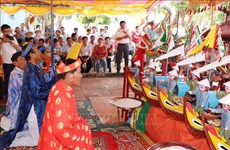Hanoi builds firm foundations for future
Fifty eight years after its liberation from French occupation, Hanoi has now taken on a new face with bright prospects, worthy of being the heart of the country.
The spirit and tradition of the Capital Liberation Day (October 10, 1954-2012) have been nurtured over the past more than half a century, giving Hanoi more vitality in its renewal path.
From a small and backward town with an area of around 130 sq.km and nearly 400,000 people, Hanoi has grown into a large and modern city covering more than 3,300 sq.km with a 6.5 million population.
After the success of the anti-French resistance war that completely liberated Hanoi, the municipal Party Committee, authorities and people immediately set out to re-build the capital city.
Over the past decades, Hanoi has always maintained its leading position with a GDP growth rate 1.5 times higher than the country’s average level and contributing more than 20 percent of the national GDP.
After its administrative boundaries were expanded on August 1, 2008, Hanoi now has a new position. Under the Party Politburo’s resolution on the capital city’s development in the 2011-2020 period, Hanoi will serve as a political-administrative centre of the country, a major centre of culture, science, education, economics and international transactions, playing as a driving force for the development of the Red River Delta, the northern key economic region and the whole country.
The recently-approved Capital Socio-economic Development Master Plan by 2020 with a vision to 2030 and the Capital Construction Master Plan by 2030 with a vision to 2050 are considered important premises for Hanoi to enter a new stage – building and developing a modern capital city.
Besides its achievements, Hanoi has still seen many weaknesses and limitations such as uneven economic development; low competitiveness; lack of key products; limited linkages and cooperation with other localities, ministries and centrally-run agencies; and poor urban planning, construction and management.
To overcome these challenges, the city has been determined to speed up administrative reforms, renovate personnel work and focus resources on developing technical and social infrastructure, especially transport, water supply and drainage, and environmental pollution treatment systems.
Amid numerous difficulties and unpredictable changes in the domestic and global situation, Hanoi, with its dynamic and methodical steps, has recorded great achievements in curbing inflation, stabilising the macro economy and ensuring social security.
Hot issues such as houses for low-income earners, traffic infrastructure improvement, delayed projects, shortage of schools, and environmental pollution have been solved. Poverty reduction and support for policy beneficiaries have also seen satisfactory results.
Hanoi has helped an average 20,000 households escape from poverty each year while eliminating dilapidated houses and building new homes for more than 3,700 households with difficulties. The development gap between urban and rural areas has been gradually narrowed.
Celebrating the 58th anniversary of the Liberation Day and entering a new stage of development, Hanoi is determined to creatively apply the Party’s resolutions and bring into full play its combined strengths, both materially and spiritually, in order to deserve to be the heart of the nation.-VNA











